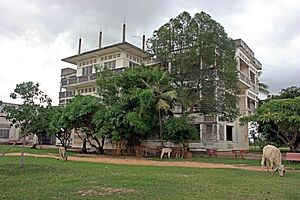Ta Mok facts for kids
Quick facts for kids
Ta Mok
|
|
|---|---|
| តាម៉ុក | |

Ta Mok in 1999.
|
|
| Born |
Chhit Choeun
1924 Takéo, Cambodia, French Indochina
|
| Died | 21 July 2006 (aged 81–82) Phnom Penh, Cambodia
|
| Years active | 1970–1999 |
| Known for | Military leader of the Khmer Rouge |
| Political party | Communist Party of Kampuchea Party of Democratic Kampuchea |
|
Date apprehended
|
6 March 1999 |
Ta Mok (Khmer: តាម៉ុក; born Chhit Choeun, ឈិត ជឿន; 1924 – 21 July 2006) was a Cambodian military leader. He was a very important figure in the Khmer Rouge, a political group that ruled Cambodia. He was also known as "Brother Number Five" or "the Butcher." Ta Mok led the national army of Democratic Kampuchea, which was the name for Cambodia under the Khmer Rouge. He was caught near the border of Thailand and Cambodia in 1999. He stayed in government care until he passed away in 2006.
Contents
Early Life and Beginnings
Ta Mok, whose real name was Chhit Choeun, was born in 1924. He was the oldest of seven children. His family lived in a village called Pra Keap in Takéo Province, Cambodia. They were a well-off family.
When he was young, in the 1930s, he became a Buddhist monk. However, he left the monkhood at age 16. In the 1940s, Ta Mok joined groups that fought against foreign rule. First, he resisted the French who controlled Cambodia. Then, he fought against the Japanese. In 1952, he joined the Khmer Issarak, a group fighting for Cambodia's independence. Soon after, he became part of the Khmer Rouge, a communist political movement.
Role in the Khmer Rouge
By the late 1960s, Ta Mok had become a general. He was the chief-of-staff for the Khmer Rouge army. He was also a key member of the Khmer Rouge's main leadership group. He became very powerful, especially in the southwest part of Cambodia.
Pol Pot, the leader of the Khmer Rouge, named Ta Mok as the head of the national army. Around 1970, during the Cambodian Civil War, Ta Mok lost part of one leg in a battle.
Ta Mok was involved in many large-scale actions during the Khmer Rouge's rule. The Khmer Rouge took full control of Cambodia on April 17, 1975. Before this, Ta Mok's forces were involved in events that led to many people being killed or forced to work. For example, after capturing a town called Oudong in 1974, many civilians were forced into hard labor.
He was also responsible for directing large-scale purges (removals of people) during the time of Democratic Kampuchea (1975–1979). These actions led to the deaths of many people, including about 30,000 in the Angkor Chey area. Because of these events, he was given the nickname Butcher.
After the Khmer Rouge Regime
After the Khmer Rouge government was overthrown in 1979 by Vietnamese forces, Ta Mok remained a strong leader. He controlled the northern areas where the Khmer Rouge still had power. His main base was in Anlong Veng. It is thought that about 3,000 to 5,000 fighters remained loyal to Pol Pot and were led by Ta Mok.
In 1997, the Khmer Rouge group split. Ta Mok took control of one part and called himself the supreme commander. Pol Pot then left the Khmer Rouge's northern stronghold. He was later put under house arrest. In April 1998, after a new government attack, Ta Mok fled into the forest. He took Pol Pot with him. A few days later, on April 15, 1998, Pol Pot passed away while in custody.
In 1997, Ta Mok was interviewed by a journalist named Nate Thayer. He did not show regret for his actions. He discussed the number of people killed by the Khmer Rouge, saying he had only killed Vietnamese.
In 1998, many key members left the Khmer Rouge. This forced Ta Mok to flee to Anlong Veng. On March 6, 1999, the Cambodian army captured him near the Thai border. He was taken to the capital city, Phnom Penh. Ta Mok was the last main leader of the Khmer Rouge who was still free in Cambodia. Other important figures had either died or made agreements with the government.
While in prison, Ta Mok's time in detention was extended many times. He was not brought to trial quickly. In February 2002, he was charged with serious actions against humanity. Ta Mok was not in good health and had breathing problems. He was only released from his cell to go to the hospital. On July 21, 2006, he passed away in a military hospital. This happened after he fell into a coma due to heart problems.
A study in 2023 looked at villages that Ta Mok governed during the Khmer Rouge time. It found that these villages still have worse economic development today. This is compared to villages that were governed by other, less extreme, parts of the Khmer Rouge.
Images for kids



